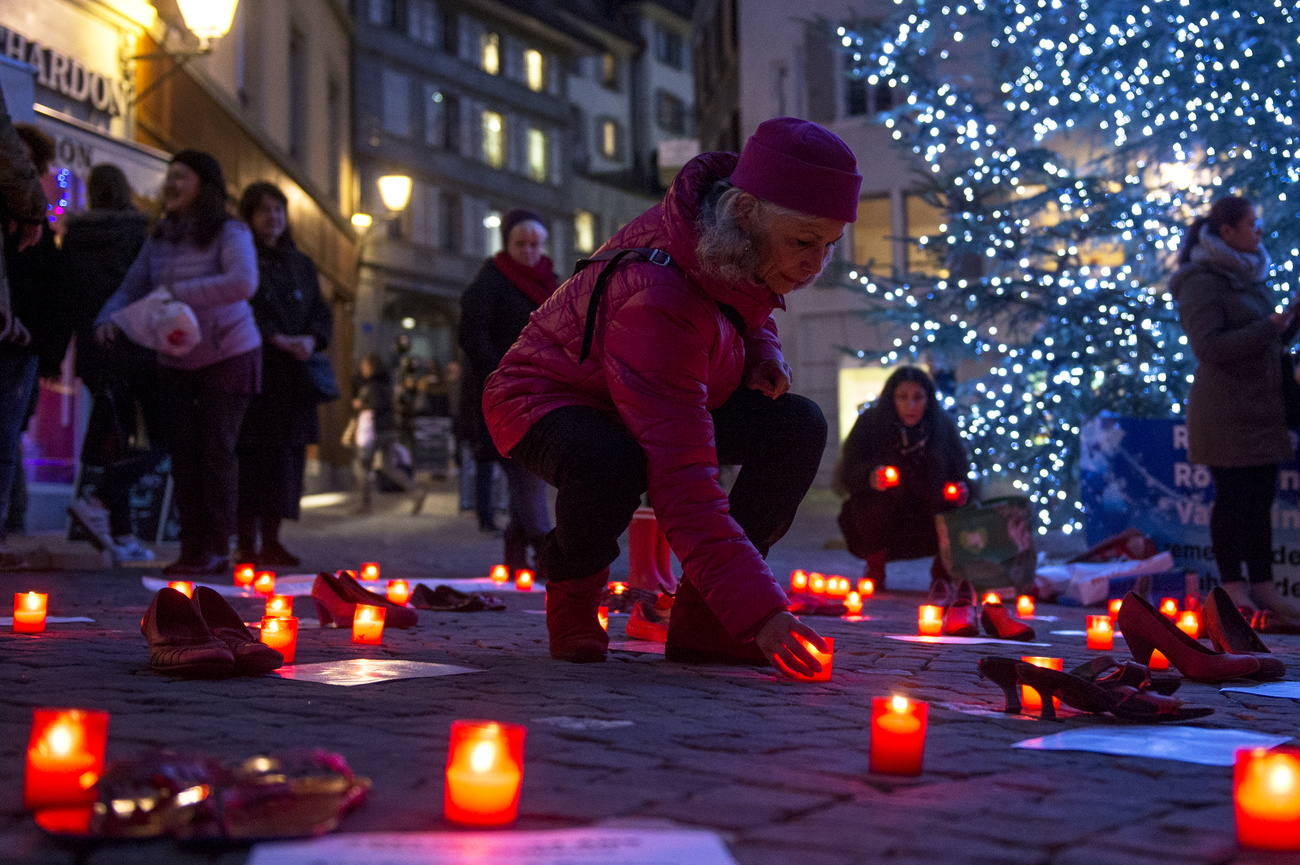Why counting femicides is a global issue

Femicide is underestimated in most countries because of a lack of reliable data. This month the United Nations adopted recommendations for collecting statistics on crimes targeting women. The guiding principle behind the new framework for data collection, which Switzerland supports, is that a problem cannot be resolved if it cannot be measured.
Gone are the days when the term “femicide” was seen as radical because feminist activists were behind the push to use it to describe the murder of women and girls because they are female. Today the United Nations defines femicide as “the most extreme and brutal manifestation of violence against women”.
The international community has set itself the objective of eradicating a problem that “affects all countries”. Until now efforts have been limited by difficulties over how to correctly identify and quantify femicides.
More
The more recalcitrant argue that the term femicide is meaningless and “homicide” is a sufficient descriptor. Sometimes the definition overlaps with domestic violence. Some feminist groups have called for an even broader definition to include the killing of any woman, even an accidental one, such as death linked to an illegal abortion.
Disagreements over a definition stem in part from the lack of reliable, harmonised international statistics. Yet activists fighting violence against women stress the need for quality data.
When gender stereotypes lead to murder
The UN wants to inject some order into this mess. In the culmination of three years’ work, the UN Statistical Commission approved a new “Statistical framework for measuring the gender-related killing of women and girlsExternal link” on March 4External link.
“The absence of data is a major obstacle in the fight [against femicide],” UN Women executive director Sima Bahous said when presenting the document. “We can act better on what we can measure.”
Enrico Bisogno, head of the section for the development and dissemination of data at the UN Office on Drugs and Crime (UNODC), which developed the recommendations in collaboration with UN Women, says the new statistical framework has several objectives.
“[It aims to] statistically define femicides in the most exhaustive manner possible […] encourage national authorities to produce the data [and] give them directives as to how to do it,” Bisogno tells swissinfo.ch.
The first step was to conclusively define femicide, with the UN making it clear that not all murders of women and girls are femicides. To qualify as a femicide, the murder must be both intentional and gendered. “Gender-related motivation” refers not only to the specific motivation of the perpetrator, but also to the root, societal causes.
Notably, the framework cites “the ideology […] of privilege of men over women, the social norms around masculinity”, or “the need […] to have gender roles respected”.
“These factors can trigger violence from the perpetrators when the behaviour of a woman is perceived as non-compliant.”
Markers of femicide
The second step was to establish criteria to objectivise the influence of gender. This defining characteristic of femicide is also the most difficult to assess and measure.
Currently, the UNODC collects statistics on domestic violenceExternal link from member states which it uses to create international comparisons. This enables analysts to track how the phenomenon is developing over time and across countries.
There are many forms of femicide. Murders of women committed in the private sphere are typically considered femicides as they are rooted in traditional social gender norms. Those perpetrated within a couple “are often linked to a need to reaffirm masculine control”, the UN statistical framework notes. Family members are usually the perpetrators of honour crimes, a type of violence against women in which the killers justify their actions by claiming she brought shame on the family or community through her actions [for example, choice of partner, pre-marital sex, education]. Dowry-related murders are also “rooted in societal and cultural norms”.
The UNODC readily acknowledges the data’s limits. For countries which already try to quantify femicide, the indicators and variables used differ widely, making international comparisons nearly impossible. In addition, some countries provide incomplete data, others provide none. Murders committed in the private sphere only represent about 60% of the femicides committed around the world, according to Bisogno.
Globally, 81,000 women and girls — one every 11 minutes — were killed in 2020, including 47,000 (58%) in the private sphere, according to the UNODC.
In the belief that domestic violence statistics hide a large proportion of femicides, several feminist collectives, research groups and the media have initiated their own monitoring of such crimes.
In Switzerland, the work conducted by Stop Femizid since 2020 typically gets media attention. Other notable contributors to the collection of femicide data include the UK’s Femicide Census, research undertaken by French newspaper Liberation, the Italian organisation Casa delle donne per non subire violenza, Spain’s femniicidio.net, Belgian blog Stop feminicide, and Russia’s femicide.net.
But each of these private initiatives uses its own method for defining and quantifying femicide. Some, for example, choose to count all women killed by men no matter what the circumstance, which the UNODC believes is incorrect.
The new UN framework for collecting data recommends counting all murders of women in the domestic sphere as femicide. It also recommends analysing eight characteristics linked to the context of the crime and its modus operandi, considered to be indicators of the gendered dimension of the crime.
The UN encourages member states and civil society to adopt its statistical standard, but they are not obligated to do so. “It will not happen from one day to the next,” says Bisogno.
And in Switzerland?
Member of the Istanbul ConventionExternal link on the fight against violence against women since 2018, Switzerland is in the middle of the pack in European comparisons in terms of domestic violence. At 0.48 for 100,000, the rate of women killed in the context of a couple, or a family relationship is lower than in Finland and Germany, but higher than in France and Italy.
Although the number of murders itself is low, the proportion of those committed by intimate partners is high, around 40%, according to Sina Liechti, head of communications at the Federal Office for Gender Equality (FOGE).
A 2021 studyExternal link commissioned by the Swiss government shows that the overwhelming majority of domestic murders are committed by men (90%) and have women as victims (96%). This has remained stable over the last 25 years, despite a general decline in all other kinds of murders.
In 2016, a “Gendered analysis of violent deathsExternal link”, published by the Small Arms Survey, a non-government organisation based in Geneva, found that Switzerland was one of the few developed countries with a higher rate of murder – of any kind – for women than men.
Switzerland is considered a good student in terms of providing police statisticsExternal link (on which the above graphic is based). Swiss data distinguishes between murders of women both inside and outside the private sphere, the sex of victims, the perpetrators, and the precise relationship between the two. The country’s approach aligns with the previous UNODC standards.
The Swiss government has “approved in general termsExternal link” the new statistical framework. It believes “a common statistical approach must be defined to allow comparisons and assist evidence-based decision-making”. But the question remains as to how to put the principles into practice. Aligning with the UN recommendations has legal and practical implications which still need to be analysed, the different services concerned at the Federal Statistics Office (FSO) told swissinfo.ch.
This will require awareness and resources reaching all the way to crime scenes, to enable the police collecting and reporting contextual elements of femicides to adapt their methods. It is too early to say if this will be technically or materially possible, and work on the subject is planned for this year.
“Both the government and cantonal police are sensitive to this issue and will have to find solutions to identify and report the issue in its entirety,” said the FSO.
Translated from French by Sophie Douez

In compliance with the JTI standards
More: SWI swissinfo.ch certified by the Journalism Trust Initiative










You can find an overview of ongoing debates with our journalists here . Please join us!
If you want to start a conversation about a topic raised in this article or want to report factual errors, email us at english@swissinfo.ch.